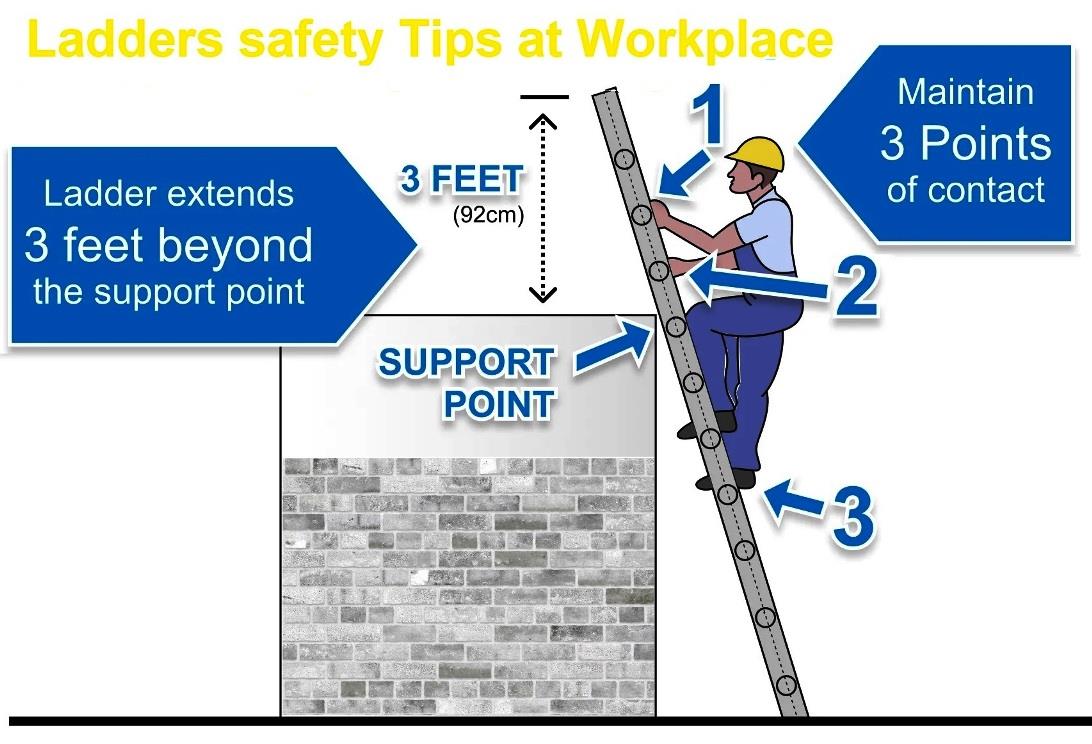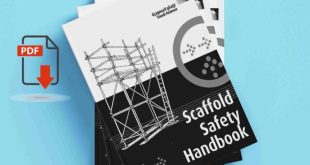Ladders can be used to perform a wide range of tasks with relative safety. Provided the ladder is in good condition and it is used correctly, within its limitations. Falls from ladders have the potential to cause serious injury so it is important that ladders are used correctly and safely.

Planning and Assessment of Risks
It is important that each job performed on site is thought about and planned for safety. Prior to working from ladders, the following points need to be considered:
- Can the job be performed in a safer manner? Can something safer and more stable be used to perform the job? e.g. temporary ‘not bolt’ staging.
- Preference should be given to the use of work platforms that are more stable than ladders.
- When you are going/about to use a ladder select the most appropriate ladder for the task and check to ensure it is in good condition and safe to use prior to starting the job.
- Do not use ladders that have been modified in any way.
- When setting up ladders, assess the work site conditions before starting work. Factors to consider:
* Wind exposure;
* Movement of vehicles and personnel in the work area;
* The nature of the work you are going to be doing;
* The weight of materials to be handled and the type of tools that are going to be used.
Safe Work Practices
Safe use of Ladders
- Ladders should only be used on a stable level surface.
- The ladder should never be placed near the edge of a penetration or opening, where if an accident occurred you can fall over the edge.
- When ladders are used behind doors or in high-traffic areas, the door should be locked or the area adequately cordoned off.
- Metal ladders should not be used for electrical work.
- Ladders should be positioned close enough to the work location so it is not necessary to lean excessively out from the ladder to carry out work. As a general rule, your belt buckle should stay inside the line of the stiles.
- Ladders must not be set up on scaffolds to gain extra height.
- Always face the ladder when climbing or descending.
- Tools should be carried in a shoulder bag or raised and lowered with a rope from the working position. This enables both hands to be kept free to climb. Materials that cannot be safely lifted or raised, should be independently transferred to the work location by some other means e.g. forklift or crane.
- Only one person should work from a ladder unless it has been specifically designed to carry the extra weight.
- Work that involves restricted vision or hot work such as welding or oxy-cutting, should preferably not be performed from a ladder. Preference should be given to the use of temporary work platforms.
- Only power tools that can be easily operated with one hand should be used when working from a ladder, otherwise you may lose your balance.
- Ladders should not be used to support scaffold planks or any other structures that they were not designed to support.
- Ladders should not be used for any purpose other than what they were designed for.
- Defective or unsafe ladders should be taken out of service and labeled ‘DO NOT USE’ using a danger tag until they have been either repaired or destroyed. Report all faults to your supervisor.
- Avoid standing too high on ladders. Standing too high creates instability and could lead to a serious fall.
- Step Ladders. Don’t stand above the third rung/tread from the top.Single Ladders. Don’t stand any higher than 1 meter below the top step or rung of the ladder.
Safety Use of Step Ladder
- Place step ladders at right angles to where the work is being performed and close enough to the job as to avoid overreaching.
- Step ladders should only be erected on a secure level surface where the spreaders can be fully locked out with all four feet resting firmly on the floor.
- Avoid using step ladders in the folded position. The non-slip feet on step ladders are usually designed to be in contact with the ground when the ladder is in the open position and may slip if placed at the wrong angle.
Safe Use of Single Extension Ladders
- Single or extension ladders should be placed at an angle of approximately 75 degrees or horizontally out at a ratio of 1 out for every 4 up.
- Ladders should be lashed and secured at the top and extended a minimum distance of 1 meter above the step-off point.
- Ladders should be tied at the base where there is a risk of the ladder slipping.
- Safety Checklist for LaddersGeneral
- Non-slip safety feet are present and in good condition.
- All rungs are in good condition.
- The stiles are in good condition.
- Has the ladder suffered any physical damage? Have moisture, chemicals or excessive heat affected the ladder?
- Spreaders or ropes on step ladders should be checked to make sure they are in good condition.
- Check metal ladders for twisting, distortion, loose or bent rungs, excessive wear (particularly on rungs), and any signs of oxidization and corrosion.
- Check timber ladders for rot, decay, mechanical damage, warped stiles, excessive cracking, splintering, loose rungs, and signs of excessive wear and tear.
- Check glass-reinforced plastic ladders for any structural or mechanical damage.
Reporting of Faults/Hazards
Faulty equipment should not be used and brought to the attention of your supervisor to enable action to be taken to fix the equipment.
Each one of us should aim to work safely and prevent unsafe situations from arising. Where unsafe situations are identified action needs to be taken to prevent accidents from occurring.
Contact your supervisor or where possible, fix the problem yourself.
- 🖇GET OSHA LADDER SAFETY TRAINING SLIDE👇
 Boilersinfo Boiler and Mechanical Power Digital Library
Boilersinfo Boiler and Mechanical Power Digital Library





